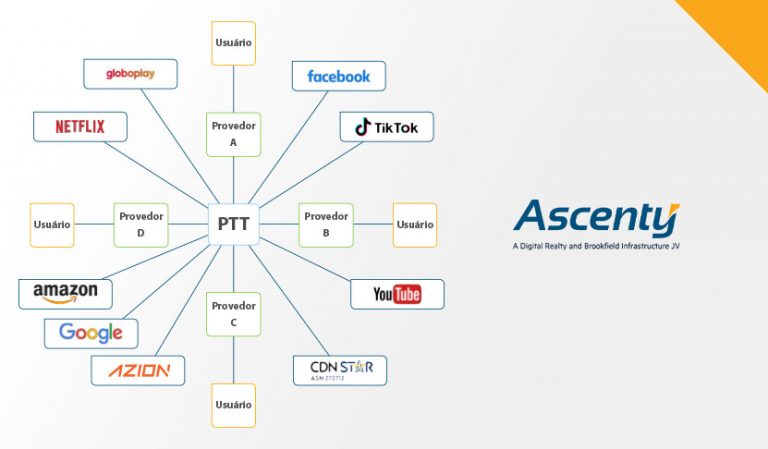Peering: Understanding the Power of Network Interconnection
In today’s digital age, the internet plays a leading role. That’s why the ongoing pursuit of improvements in its infrastructure drives advancements in capacity, security, and speed. Peering is a crucial component in this landscape!
Have you come across this concept before? Do you understand how it works? As a specialist in digital infrastructure, Ascenty recognizes that some terms and services can generate doubts among professionals and consumers.
To address these concerns, we have prepared this article to clarify the power of network interconnection for your business. Stay with us!
What does peering mean?
Peering refers to the direct interconnection between ISP networks and Autonomous System Networks (ASNs). This results in efficient, secure, and faster data traffic.
This strategy is particularly beneficial for Internet Service Providers (ISPs) and content providers. By leveraging peering, they can enhance the end-user experience, ensuring a superior quality of service.
Types of peering
There are currently two types of peering: public and private. The following is a brief overview of their main characteristics:
- Public peering: involves direct interconnection via public Internet Exchange Points (IXPs), such as IX.BR. In this model, multiple internet providers connect and share traffic.
- Private peering: involves the interconnection of dedicated and private networks. This is particularly useful in cases involving large volumes of data.
How does an IXP work?
The Internet Exchange Point (IXP) serves as a centralized data traffic location, where multiple networks converge to enhance network connectivity. In essence, it is a physical location that distributes traffic, thereby accelerating and enhancing the efficiency of the information pathway.

How does this process unfold in practice? To illustrate, consider two users who wish to play an online game, each connected to a different operator from their home.
Although operators A and C lack a direct connection to each other, they are interconnected via an IXP. This enables users to exchange messages and interact more quickly, without their operators having a connection network just for that.
What are the advantages of a peering strategy?
As previously mentioned, a peering strategy enables internet providers to direct data traffic more efficiently and strategically. This allows them to select a more direct and expeditious route.
Do you recognize the advantages this brings to both the company and the end user? Understanding this is key!
Reduced latency
Peering offers a significant benefit in the form of low latency. This results in a more fluid user experience, with a significantly reduced response time to commands.
By taking a shorter route, data flows more quickly between the user and the server.
Improved user experience
With reduced latency, there are fewer delays in the server’s response. This results in fewer interruptions and packet losses, as well as enhanced video resolution.
These benefits contribute to a positive and lasting relationship with your internet provider.
What are the benefits of peering for internet providers?
According to Anatel’s Panorama Reclamações 2023 complaint report, consumers have registered more than 1 million complaints regarding the quality of internet services. This substantial figure underscores the significant challenges the sector continues to face.
Of all the complaints registered, those related to the quality and functionality of services represent the second highest volume. These complaints are second only to those related to billing issues.
In this context, it can be concluded that a well-designed peering strategy can contribute to reducing these rates. This is due to the intelligent direction of data traffic, which enables providers to deliver enhanced services.
It’s simple: lower latency means a much more responsive connection experience, aligned with user expectations. This allows ISPs to showcase both the quality of their services and their commitment to continuous improvement.
How can Ascenty support your business?
As the leading provider of data centers and connectivity in Latin America, Ascenty offers world-class digital infrastructure to securely store your information—along with solutions that ensure fast, secure data traffic.
One standout solution is our Internet Exchange (IX). By choosing this service, your company gains direct access to the networks of major internet providers and organizations with Autonomous Systems (AS).
Ascenty is the ideal environment to accelerate information exchange and ensure low-latency, high-performance traffic. We bring together the world’s largest content providers in an extensive and robust connectivity ecosystem.
Want to learn more about our solutions for internet providers? Talk to one of our experts today!


